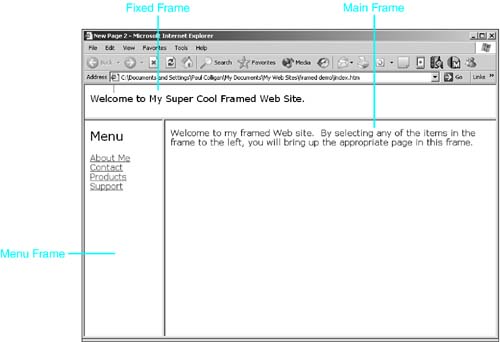| Frames were a technology introduced by Netscape in version 2 of its browser. This fairly old technology caught on quickly and has been steadily declining in use since introduction (and some dare say abuse). Numerous pros and cons exist for using frames in Web design, and we'll examine them here. We'll also take a look at how FrontPage handles frames and examine the newer technology of inline frames, as well as how to add them to your Web. Navigation in a Web site is never an easy task. Giving users a means to quickly find their way through your site is the dream of every Webmaster and a simple requirement of good Web design. What is the point of a non-linear communication tool if people have to start from the beginning and work their way through? What Are Frames and Why Would You Use Them? Frames enable the developer to divide a Web site into different sections, each with its own scrollbars and navigational capabilities (see Figure 11.1). Each section is called a frame because it "frames" a separate Web page. The total of the framed pages is called the frameset. A frameset allows for an easy navigation because each section (frame) behaves independently from the others. Figure 11.1. Web navigation is easy to build and implement with a framed Web site. 
It is common for a developer to develop a manageable frameset for a site and then quickly produce a series of content pages for the main frame. Not having to focus on navigational elements for every page of a site can expedite the Web design process and provide an easy model for navigation. You'll find that a frameset is very easy to create and implement in a Web site. No coding or scripting is required because FrontPage does everything needed through the FrontPage interface. Why use frames in Web design? They are very easy to design and implement. Once a frameset is implemented, the developer can quickly create the rest of a site by simply adding links to pages as needed in the menu frame. They are very easy for the user to navigate. A framed Web page design is very easy for the user and leaves little room for mistake on the part of the reader.
When Not to Use Frames There are numerous reasons not to use frames in Web design: Not all browsers support them. Some browsers simply don't support frames. In addition, as the rise of browsers on smaller forms (such as cell phones) continues, there is simply no way to implement frames, and therefore they don't. Nothing is more frustrating than designing a Web page or site that isn't available to all of your readers. They wreak havoc with the search engines. Because framed pages are all individual pages, many search engines will index each of these pages individually and might not put them together the "right way" if someone comes through their index. They are very hard to print. The idea of a paperless society is nice but is simply not reality. People print Web pages that they can later reference; and printing framed pages is not only very complicated, but also hard to put together in a way that makes sense in a printed paradigm. Hyper linking within Frames is much more complicated than the traditional hyperlink. If implemented incorrectly, you can link to a framed site within a framed site, producing a never-ending spiral known by some as "frame hell." Technologies now exist that make frames unnecessary. This is the most important reason to shy away from frames. The benefits afforded by frames can be easily replicated through intelligent Web design. We'll examine this issue in more detail later in this chapter.
TIP My strong opinion is that frames should not be part of modern Web design. The hassles considerably outweigh the disadvantages. Although I understand the benefits provided by frames, I am thoroughly convinced that you can get them through other means. You should still read this chapter through to fully understand the implications of using frames. If that argument doesn't convince you, look at the top 100 sites in any list anywhere and tell me how many of them use frames.
Considerations When Using Frames If you must use frames, remember the following: You'll need to provide an alternative for browsers that don't support frames. Telling users to update their Web browser to something that supports frames is not an option for many users (see Figure 11.2). If there is any option that your site might attract users with unsupportive browsers, you'll need to design your site in such a way that you can serve the information to them as well. If you find yourself designing for a project in which only one browser option is available (often the case in an intranet project), frames might be a viable option for you. Figure 11.2. A frameset provides a default message for users unable to use frames. FrontPage's default message is shown here. 
You'll need to provide for search engines that won't provide for your site structure. This can either be done with client-side scripting or a disclaimer on each of your content pages. You should provide printing directions. If you might think that any of your users will print your site, you'll need to give them directions for doing so. Be careful to use the correct linking options when linking within frames. You don't want to catch your users in "frame hell." You'll need to keep screen size in consideration. Plenty of people are still surfing the Internet with 15-inch monitors. A frameset that might look perfect on your desktop might be unreadable on older display technology. Make sure to test your framesets for screen size compatibility.
 | If you are having problems with your links opening the right content in the wrong frame, see "Links within My Frames Are All Tweaked" in the "Troubleshooting" section at the end of this chapter. |
| 
